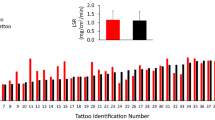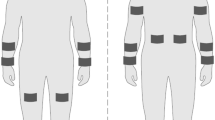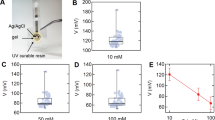Summary
Nineteen healthy male subjects, differing in training status and\(\dot V_{{\text{O}}_{{\text{2max}}} } \) (52±1 ml · min−1 · kg−1, mean ±SEM; 43–64 ml · min−1 · kg−1, range), exercised for 1 h at an absolute workload of 192±8 W (140–265 W); this was equivalent to 70±1%\(\dot V_{{\text{O}}_{{\text{2max}}} } \) (66–74%). Each exercise test was performed on an electrically braked cycle ergometer at a constant ambient temperature (22.5±0.0° C) and relative humidity (85±0%). Nude body weight was recorded prior to and after each exercise test. Absolute sweat loss (body weight loss corrected for respiratory weight loss) during each test was 910±82 g (426–1665 g); this was equivalent to 1.3±0.1% (0.7–2.2%) of pre-exercise body weight (relative sweat loss). Weighted mean skin temperature and rectal temperature increased after 5 min of exercise from 30.5±0.3° C and 37.2±0.1° C respectively to 32.5±0.2° C and 38.8±0.1° C respectively, recorded immediately prior to the end of exercise. Bivariate linear regression and Pearson's correlation demonstrated absolute sweat loss was related to\(\dot V_{{\text{O}}_{{\text{2max}}} } \) (r=0.72,p<0.001), absolute exercise workload (r=0.66,p<0.01), body surface area (r=0.62,p<0.01), weight (r=0.60,p<0.01) and height (r=0.53,p<0.05). Relative sweat loss was related to\(\dot V_{{\text{O}}_{{\text{2max}}} } \) (r=0.77,p<0.001) and absolute exercise workload (r=0.59,p<0.01). There was no relationship between sweat loss (absolute or relative) and heart rate, skin temperature or rectal temperature. In addition, there was no relationship between rectal temperature or absolute exercise workload or\(\dot V_{{\text{O}}_{{\text{2max}}} } \). Stepwise multiple linear regression indicated\(\dot V_{{\text{O}}_{{\text{2max}}} } \) to be the most important predictor of absolute (r=0.72,F=18.27,p<0.001) and relative (r=0.77,F=24.58,p<0.001) sweat loss in man during prolonged exercise.
Similar content being viewed by others
References
Baum E, Bruck K, Schwennick HP (1976) Adaptive modifications in the thermoregulatory system of long distance runners. J Appl Physiol 40:404–410
Benzinger TH (1962) The thermostatic regulation of human heat production and heat loss. 22nd Int Congr Physiol Sci, Leiden, pp 415–438
Bittel JHM, Buguet AGC (1980) Improved response to heat after moderate physical training in man. Experientia 36:560–562
Costill DL, Bowers R, Kammer WF (1970) Skinfold estimates of body fat among marathon runners. Med Sci Sports 2:93–95
Drinkwater BL, Denton JE, Kupprat IC, Talag TS, Horvath SM (1976) Aerobic power as a factor in women's response to work. J Appl Physiol 41:815–821
Fox RH, Ferris E (1968) Thermoregulatory function in athletes. 24th Int Congr Physiol Sci, Washington DC
Gisolfi CV (1973) Work-heat tolerance derived from interval training. J Appl Physiol 35:349–354
Henane R, Flandrois R, Charbonnier JP (1977) Increase in sweating sensitivity by endurance conditioning in man. J Appl Physiol 43:822–828
Irion GL (1987) Responses of distance runners and sprinters to exercise in a hot environment. Aviat Space Environ Med 58:948–953
Maughan RJ, Leiper JB (1983) Aerobic capacity and fractional utilisation of aerobic capacity in elite and non-elite male and female marathon runners. Eur J Appl Physiol 52:80–87
Mitchell D, Wyndham CH (1969) Comparison of weighting formulas for calculating mean skin temperature. J Appl Physiol 26:616–622
Mitchell JW, Nadel ER, Stolwijk JAJ (1972) Respiratory weight losses during exercise. J Appl Physiol 32:474–476
Nielsen B, Nielsen M (1965) On the regulation of sweat secretion in exercise. Acta Physiol Scand 64:314–322
Piwonka RW, Robinson S, Gay VL, Manalis RS (1965) Preacclimatization of men to heat by training. J Appl Physiol 20:379–384
Saltin B, Hermansen L (1966) Esophageal, rectal, and muscle temperature during exercise. J Appl Physiol 21:1757–1762
Shvartz E, Shapiro Y, Magazanik A, Meroz A, Birnfedl H, Mechtinger A, Shibolet S (1977) Heat acclimation, physical fitness, and responses to exercise in temperate and hot environments. J Appl Physiol 43:678–683
Author information
Authors and Affiliations
Rights and permissions
About this article
Cite this article
Greenhaff, P.L., Clough, P.J. Predictors of sweat loss in man during prolonged exercise. Europ. J. Appl. Physiol. 58, 348–352 (1989). https://doi.org/10.1007/BF00643508
Accepted:
Issue Date:
DOI: https://doi.org/10.1007/BF00643508




